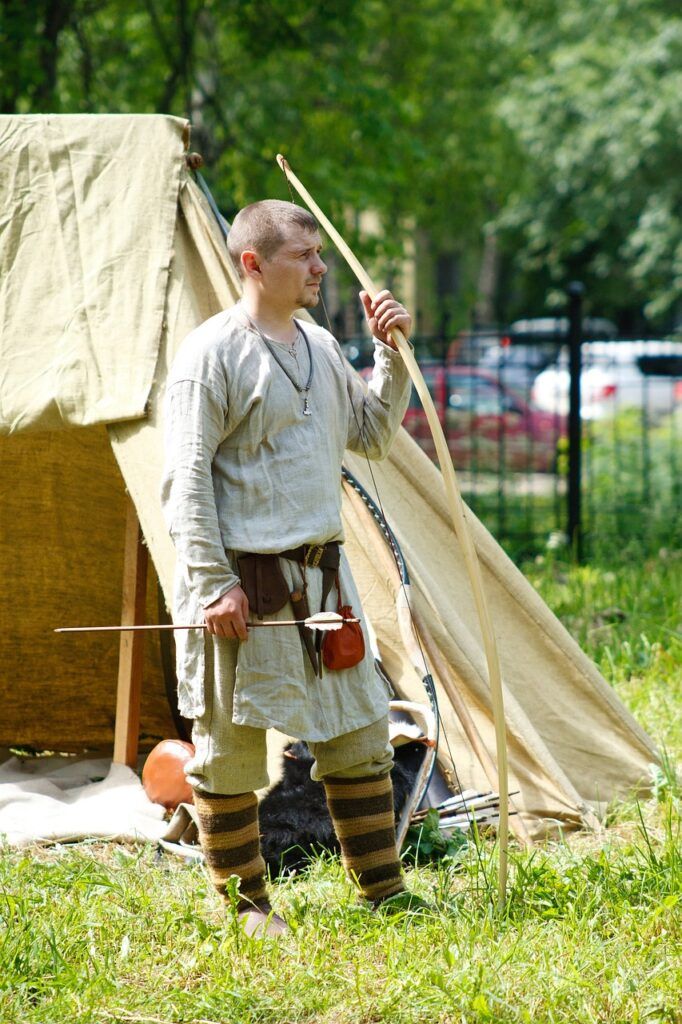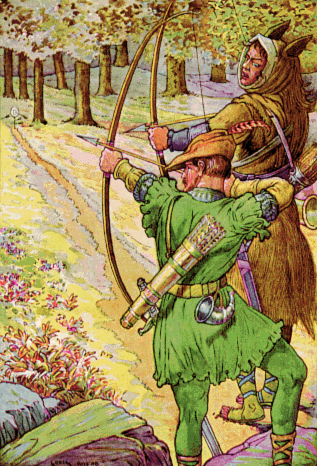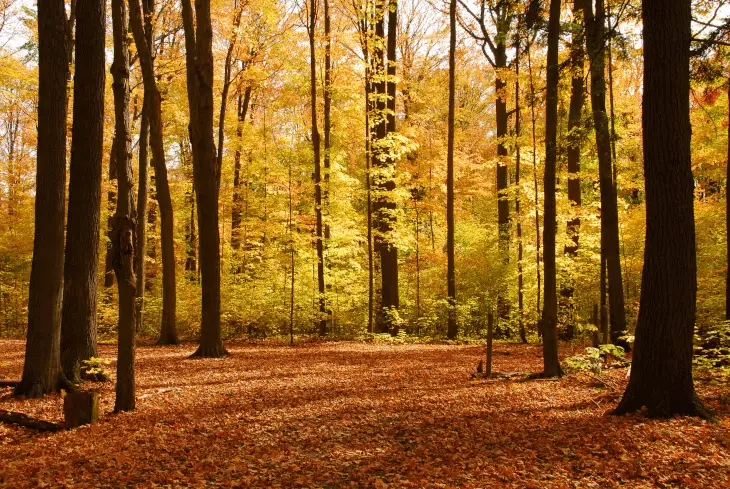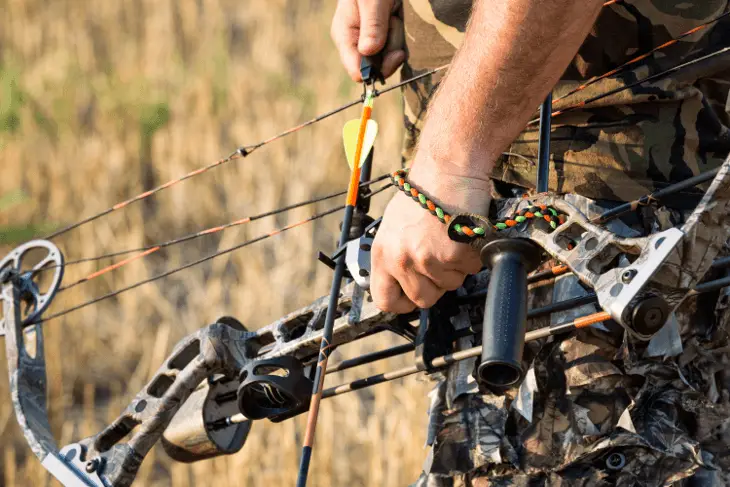Note: Our site links to archery and bowhunting products sold by outside vendors, and we may earn a small commission if you purchase an item after clicking one of these links. Learn more about our affiliate program.
I love longbows. They’re sturdy, they’re works of art, and they’re perfect mix of archery and history. If you use a recurve or a compound and you like archery, chances are very strong you’re eventually going to fall in love with longbows.
In this post, I’ll introduce longbows—what they are and how they work—and then I’ll discuss the differences between a regular recurve and a longbow. Then I’ll briefly discuss something called the War Bow (woah!), and finally I’ll go over what I consider four of the best longbows and why they’re fantastic. Then I’ll get a little indulgent and opine about why I’m in love with longbows.

What Is a Long Bow?
Longbows look very simple, but they’re actually very unique. Here are some of the most prominent characteristics of a longbow:
- Length. Let’s get the obvious characteristic out of the way first: a longbow is very, very long. That may seem obvious, but compared to other bows, it’s enormous: compound bows keep shrinking as time goes on, horse bows were made to be small so archers could use them while riding, and recurve bows, while larger than most contemporary bows, are still a second place. And there’s a reason longbows are so tall: they’re supposed to be roughly the size of the archer shooting it (or up to three inches longer than the archer), so it’s not uncommon to see longbows that are five to six feet tall.
- Shape. When strung, longbows have a general “D” shape. If you look at the top of the bow, you’ll see that the string doesn’t touch the bow at the top limb or the bottom limb, and that differentiates it from recurves, where the string actually comes into contact with the top limb and bottom limb, and from compounds, which have “cams,” aka wheels, at the end of each limb.
- Materials. Traditional bows are usually made from wood. A bow made from a single piece of wood is usually called a selfbow, and a bow made from multiple pieces of wood layered on top of one another is usually called a composite bow (sometimes referred to a “laminated bow”). Selfbows are often made from yew, and composite bows are often made of hickory, lemonwood, and yew. Here’s my favorite part about composite bows, and it blows my mind because it’s so clever: some types of wood are better at withstanding tension, and some types of wood are better at withstanding compression. So a composite bow would be made with hickory on the outside of the bow, because hickory is better at withstanding tension, and be made with yew or lemonwood on the inside of the bow, because lemonwood and yew are better at withstanding compression.
Difference Between a Longbow and a Recurve Bow
So now that we know a little bit about longbows, let’s take a look at their closest cousin, the recurve bow (and then we’ll get to the reviews, and hopefully find the best longbow for you).
I’ve included two images below: the top image is a recurve bow, and the bottom image is a longbow. Let’s take a look at their similarities and their differences:
- Size. Recurves a little smaller than longbows. They’re still pretty large, but most don’t have the length that longbows have. That’s the most obvious difference.
- Curves. If you look at the two images below, you’ll see that on the recurve, at the end of the top limb and the end of the bottom limb, the bow curves out, away from the archer. That’s why they’re called “recurve” bows—the limbs curve towards the archer, and then curve outward again. The recurve allows the ends of the limbs to accelerate faster than other parts of the limb, and the effect is that the bow more effectively transfers energy from the string to the arrow. The longbow does not have that “recurve,” and instead relies on its length to generate the force necessary to propel an arrow.
- Sound. Take another look at the photos below. I just mentioned the curves at the top and bottom of a recurve bow, and how the longbow doesn’t have those curves. That means that the string on a recurve bow actually has more contact with the recurve bow, whereas the string on the longbow has almost no contact at all. Recurve bows are sometimes “loud,” because you hear that the string slapping against the bow, and recurve users sometimes need to use a string silencer to keep their rig quiet.
- No Shelf. On most modern bows, there’s a shelf in the middle of the bow where the archer will place his/her arrow. Traditional bows do not have a shelf; they’re usually round from top to bottom.
- Accessories. If you want to, you can dress up a recurve with a looooot of gear. You can add sights, stabilizers, plungers, elevated rests, string silencers, and so on. Longbow archers typically forego all of that, and keep things simple.
- Poundage. In general, recurve bows have a draw weight between 15 pounds (on the very low end) and 80 pounds (on the very high end). It’s not uncommon for longbows to have draw weights much higher than recurves.
- Reach. Because longbows can utilize higher draw weights, they’re able to shoot veeeery far distances. Long-range archery contests using longbows are a ton of fun.


WHAT IS A WAR BOW??
I’ll include this factoid, just because “war bow” is about the coolest name imaginable. As I mentioned above, longbows can be made to be VERY powerful.
Make no mistake: modern bows are also very powerful. There are recurves with draw weights up to 80 pounds, and I know of a few compound bows that have draw weights of 100 pounds.
War bows could reach over 180 POUNDS OF DRAW WEIGHT, and were capable of shooting straight through medieval armor. Woah.
Mind = blown.
OK—let’s get to those reviews.
Best Longbow for Beginners: The SAS Pioneer Traditional Wood Long Bow
- Riser is made of Makore Wood and Cassia Siamea
- Strong fiberglass limb Made of Maple laminations
- Great Shape and Stablity
The SAS Pioneer Traditional Wood Long Bow is a fantastic longbow, and it’s one of my favorites.
Let’s take a look at some of the details:
- It’s made from makore wood (which is rot resistant) and cassia siamea (which is a very sturdy wood) with fiberglass reinforcement;
- It’s 68 inches long (about 5-and-a-half feet tall), so a little bit short of a traditional longbow, but definitely in the neighborhood; and
- It’s made for righties only. Sorry, lefties!
This is a fantastic model, and perhaps the best thing about this bow is it comes in a range of draw weights. Because longbows are kind of a niche product—there are far fewer longbow archers than there are recurve archers or compound bow archers—it can be difficult to find a bow that fits your needs.
Plus, here’s another amazing aspect of the SAS Pioneer: you can sometimes get it with a draw weight as low as 35 pounds. If you’re new to archery, you want to start with a bow that has a lower-pound draw weight, and most longbows have VERY high draws weights. They’re usually 50 pounds or more. So the option of getting a longbow with a draw weight of 35 pounds is pretty fantastic.
This is a minor squibble I have with this bow, but this isn’t technically a longbow, because it has a shelf, and traditional longbows were made without shelves to place the arrow. That’s me being a tightwad, though. In all other ways, this is a fantastic longbow.
PSE Archery Oryx Longbow Right Hand
- LONG BOW SPECIFICATIONS - Length: 68” Brace height: 7-1/2” – 7-3/4” Weights at 28” Draw (30, 35, 40, 45, 50, 55 LBS.)
- EASY-TO-SHOOT - Perfect for beginners, pre-teens and adult shooters. The PSE ORYX offers great accuracy and speed along with fine curves to help point long-distance targets. Everything you need for a thrilling hunting experience!
- FOR LEFT & RIGHT HAND SHOOTERS - Not limited to one hand side. Archers can easily manage with The Oryx hunting bow with either hand, whether using left or right. The traditional and easy design makes it available to everyone.
The PSE Oryx Longbow is an absolutely gorgeous model. Here are the schematics:
- The bow has a beautiful dark hue, and it’s crafted from a variety of materials: the riser is a tri-laminate composite (in other words, three layers) maple, cherry, and walnut wood, and the limbs are a bamboo-and-fiberglass combo;
- It’s 68 inches from the top limb to the bottom limb (about five-and-a-half feet tall, in other words) and its brace height 7-and-a-half to 7 and three quarter inches; and
- It’s manufactured in draw weights of 30 pounds, 35 pounds, 40 pounds, 45 pounds, 50 pounds, and 55 pounds, which is juuuuust about right for a longbow—if you’re new to archery, you’d want to go for a lower-pound version, and if you’ve got some experience, you can think about getting a higher-pound version. I would NOT recommend going for a higher-pound version if you’re new to archery—even if you are very strong. It takes time to build archery muscles, and there are no shortcuts.
When people talk about gorgeous bows, this is what they’re talking about. It’s a sleek and streamlined and beautiful instrument.
PSE is a fantastic company, and they make a LOT of archery products. They mainly focus on compound bows, so it’s nice to see them offer a traditional product. This is a very solid option for a mid-range longbow.
Bear Archery Montana Longbows
- Brand New & Original! Archery Gear Ready When You Are!
- Sport type: Hunting
We’re moving into the “high end” longbows, and the Bear Archery Montana Longbow fits that bill: it’s a piece of art! From the grain on the riser, to the thinness of the limbs, to the leather handle, this is a beautiful bow.
Let’s take a look at the details:
- It’s 64 inches from limb to limb; that’s a little shorter than most longbows, but it’s still in the ballpark;
- The limbs are made from white maple, and they’re reinforced with fiberglass; and
- The riser has a leather grip and center-cut shelf.
This is a dream bow, and the white maple limbs make it one of a kind. White maple is incredibly sturdy—they use it to build houses and floors and large furniture pieces—but that makes it very difficult to work with. That’s why you don’t see a lot of longbows made from white maple, but why you know that a bow made from white maple is going to be one tough bow.
Bear Archery is another well-known company, and they make a lot of archery supplies, from bows to apparel to high-end rests and sights. In fact, they make a line of traditional bows, and these puppies are just plain beautiful. The Montana Longbow is perhaps their most accessible offering.
Martin Archery Savannah Stealth Longbow
- 40 to 65 lb Draw Weight
- 6.5in- 7.5in Brace Height
- 1lb 7 oz. Mass Weight
The last bow on the list is the Martin Archery Savannah Stealth Longbow, and it’s perhaps the most prized.
This is another piece of art. I don’t want to get carried away, but the riser looks like the underside of an eagle wing.
The riser is made from exotic bubinga wood, which is native to Africa and has a beautiful reddish / orange-ish hue, and lined with maple for contrast. The limbs are also made from bubinga, supported by fiberglass for strength. It has a finely-shaped rest in the riser and usually comes along with one Flemish bow string.
One of the features about this bow that I appreciate is that it comes with protective material—in this case, a bow sock. It’s a shame to get something so nice and not be able to take care of it—especially a bow like this.
This is the type of thing that becomes a family heirloom. Martin Archery makes a lot of great bows, but this is among the best they offer.
Longbow Reviews: Wrapping Up
OK! That’s it for bows. The first one I mentioned—the SAS Pioneer—is a fantastic option, and it has a lot of happy users. It’s a great choice if you’re new to archery, or if you simply don’t want to go for a high-end longbow.
If you’d like to get a little fancier, the PSE Sequoia, the Bear Archery Montana, and the Martin Savannah are fantastic options.
Allow Me to Wax Poetic for a Moment
One of my favorite aspects of archery is that archers have the opportunity to embrace advances in technology, or to embrace traditions and practices from long past.
In other words, you can buy a compound bow that’s been made in a factory, or you can use a traditional bow, that’s been crafted by an artisan. You can go high-tech or old-fashioned, and that choice is yours to make.
And I’m not knocking compound bows—I use them and I love them, and I *totally* geek out on the science behind them. The physics of a modern compound bow astound me, and I can’t wait to learn about the new developments we’ll see in compound bow technology over the course of my lifetime.
But there’s something truly inspiring about traditional bows, and longbows in particular. If you go on YouTube, you’ll find hundreds of videos that people made about longbows. It’s not the most popular type of bow in the world, so why are there so many videos about them?
You might think it’s about culture. A *lot* of the videos related to longbows are shot by English people. I think the English understand that the bow was, for centuries, an integral part of English national identity. They used in wars. They hunted and fed their families with it. There’s even a mythical character, Robin Hood, who is known for three things: being English, messing with rich people, and using a bow. I think the longbow resonates with English people because it’s such an important part of their history.

But it’s incomplete to link longbows solely to the English. There are plenty of videos about longbows shot by Americans, and they’re obviously passionate about the weapon. But the appeal of the longbow is much broader than even that.
The longbow is not specific to any single culture. People from every walk of life—from Native Americans to Mongols to Hungarians to African tribes—have used the bow as tool to feed themselves and protect themselves. All around the world, we’ve taken natural materials, and transformed them into a simple-yet-sophisticated tool, and then passed down knowledge about how to build and use that tool from generation to generation. It’s kind of amazing, if you think of it that way.
So that’s the appeal—or, one of the appeals—of the longbow. Connecting with tradition, and connecting to the broader humanity who used bows to enhance their lives. Foregoing the seductive call of new technology, to reconnect with something time-honored and true and globally important.
Good Luck, and Enjoy Yourself!
If you decide to get into longbow archery, you’re in for a good time. Longbow archers are PASSIONATE about the sport, and they’re among the most knowledgeable archers you’ll meet. Good luck, and happy shooting!








